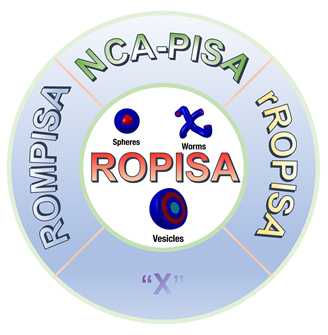[1] Kim, J. K.; Yang, S. Y.; Lee, Y.; Kim, Y. Prog. Polym. Sci. 2010, 35, 1325.
[2] Cai, C. H.; Wang, L. Q.; Lin, J. P. Chem. Commun. 2011, 47, 11189.
[3] Guan, X. L.; Wang, L.; Li, Z. F.; Liu, M. N.; Wang, K. L.; Lin, B.; Yang, X. Q.; Lai, S. J.; Lei, Z. Q. Acta Chim. Sinica 2019, 77, 1036 (in Chinese). (关晓琳, 王林, 李志飞, 刘美娜, 王凯龙, 林斌, 杨学琴, 来守军, 雷自强, 化学学报, 2019, 77, 1036.)
[4] Zhu, Y. Q.; Yang, B.; Chen, S.; Du, J. Z. Prog. Polym. Sci. 2017, 64, 1.
[5] Ma, G. H.; Yue, H. Chin. J. Chem. 2020, 38, 911.
[6] Mai, Y.; Eisenberg, A. Chem. Soc. Rev. 2012, 41, 5969.
[7] Canning, S. L.; Smith, G. N.; Armes, S. P. Macromolecules 2016, 49, 1985.
[8] Chen, S. L.; Shi, P. F.; Zhang, W. Q. Chin. J. Polym. Sci. 2017, 35, 455.
[9] Cheng, G.; Pérez-Mercader, J. Macromol. Rapid Commun. 2019, 40, 1800513.
[10] Zhao, Q. Q.; Liu, Q. Z.; Li, C.; Cao, L.; Ma, L.; Wang, X. Y.; Cai, Y. L. Chem. Commun. 2020, 56, 4954.
[11] Penfold, N. J. W.; Yeow, J.; Boyer, C.; Armes, S. P. ACS Macro Lett. 2019, 8, 1029.
[12] Liu, C.; Hong, C. Y.; Pan, C. Y. Polym. Chem. 2020, 11, 3673.
[13] D'Agosto, F.; Rieger, J.; Lansalot, M. Angew. Chem., Int. Ed. 2019, 59, 2.
[14] Tan, J. B.; Xu, Q.; Li, X. L.; He, J.; Zhang, Y. X.; Dai, X. C.; Yu, L. L.; Zeng, R. M.; Zhang, L. Macromol. Rapid Commun. 2018, 39, 1700871.
[15] Zheng, J. W.; Wang, X.; An, Z. S. Acta Polym. Sin. 2019, 50, 1167 (in Chinese). (郑晋文, 王晓, 安泽胜, 高分子学报, 2019, 50, 1167.)
[16] Mane, S. R. New J. Chem. 2020, 44, 6690.
[17] Zhu, Y.; Ye, W. L.; Liu, Z. F.; Deng, W.; Liu, M. N. Acta Polym. Sin. 2019, 50, 44 (in Chinese). (朱玉, 叶文玲, 刘志峰, 邓维, 刘美娜, 高分子学报, 2019, 50, 44.)
[18] Slugovc, C. Macromol. Rapid Commun. 2004, 25, 1283.
[19] Bielawski, C. W.; Grubbs, R. H. Prog. Polym. Sci. 2007, 32, 1.
[20] Frenzel, U.; Nuyken, O. J. Polym. Sci., Part A: Polym. Chem. 2002, 40, 2895.
[21] Bielawski, C. W.; Grubbs, R. H. Angew. Chem., Int. Ed. 2000, 39, 2903.
[22] Vougioukalakis, G. C.; Grubbs, R. H. Chem. Rev. 2010, 110, 1746.
[23] Claverie, J. P.; Viala, S.; Maurel, V.; Novat, C. Macromolecules 2001, 34, 382.
[24] Chemtob, A.; Héroguez, V.; Gnanou, Y. Macromolecules 2002, 35, 9262.
[25] Le, D.; Montembault, V.; Pascual, S.; Collette, F.; Héroguez, V.; Fontaine, L. Polym. Chem. 2013, 4, 2168.
[26] Hilf, S.; Kilbinger, A. F. M. Nat. Chem. 2009, 1, 537.
[27] Le, D.; Dilger, M.; Pertici, V.; Diabaté, S.; Gigmes, D.; Weiss, C.; Delaittre, G. Angew. Chem., Int. Ed. 2019, 58, 4725.
[28] Zhang, L. Y.; Song, C.; Yu, J. H.; Yang, D.; Xie, M. R. J. Polym. Sci., Part A: Polym. Chem. 2010, 48, 5231.
[29] Liu, J. W.; Liao, Y.; He, X. H.; Yu, J. H.; Ding, L.; Xie, M. R. Macromol. Chem. Phys. 2011, 212, 55.
[30] Yoon, K.-Y.; Lee, I.-H.; Kim, K. O.; Jang, J.; Lee, E.; Choi, T.-L. J. Am. Chem. Soc. 2012, 134, 14291.
[31] Wright, D. B.; Touve, M. A.; Adamiak, L.; Gianneschi, N. C. ACS Macro Lett. 2017, 6, 925.
[32] Foster, J. C.; Varlas, S.; Blackman, L. D.; Arkinstall, L. A.; O’Reilly, R. K. Angew. Chem., Int. Ed. 2018, 57, 10672.
[33] Varlas, S.; Foster, J. C.; Arkinstall, L. A.; Jones, J. R.; Keogh, R.; Mathers, R. T.; O’Reilly, R. K. ACS Macro Lett. 2019, 8, 466.
[34] Wright, D. B.; Touve, M. A.; Thompson, M. P.; Gianneschi, N. C. ACS Macro Lett. 2018, 7, 401.
[35] Sha, Y.; Rahman, M. A.; Zhu, T. Y.; Cha, Y. J.; McAlister, C. W.; Tang, C. B. Chem. Sci. 2019, 10, 9782.
[36] Torres-Rocha, O. L.; Wu, X. W.; Zhu, C. Y.; Crudden, C. M.; Cunningham, M. F. Macromol. Rapid Commun. 2019, 40, 1800326.
[37] Wright, D. B.; Proetto, M. T.; Touve, M. A.; Gianneschi, N. C. Polym. Chem. 2019, 10, 2996.
[38] Wright, D. B.; Thompson, M. P.; Touve, M. A.; Carlini, A. S.; Gianneschi, N. C. Macromol. Rapid Commun. 2019, 40, 1800467.
[39] Deming, T. J. Prog. Polym. Sci. 2007, 32, 858.
[40] Shen, Y.; Fu, X. H.; Fu, W. X.; Li, Z. B. Chem. Soc. Rev. 2015, 44, 612.
[41] Sun, H.; Hong, Y. X.; Xi, Y. J.; Zou, Y. J.; Gao, J. Y.; Du, J. Z. Biomacromolecules 2018, 19, 1701.
[42] Xu, Y.; Zhao, Y.; Zhang, Y. J.; Cui, Z. F.; Wang, L. H.; Fan, C. H.; Gao, J. M.; Sun, Y. H. Acta Chim. Sinica 2018, 76, 393 (in Chinese). (徐毅, 赵彦, 张叶俊, 崔之芬, 王丽华, 樊春海, 高基民, 孙艳红, 化学学报, 2018, 76, 393.)
[43] Lv, M. X.; Mai, W. P.; Lu, Q.; Duan, B. C.; Zhao, Y. F. Chin. J. Org. Chem. 2018, 38, 148 (in Chinese). (吕名秀, 买文鹏, 卢奎, 段冰潮, 赵玉芬, 有机化学, 2018, 38, 148.)
[44] Deming, T. J. Nature 1997, 390, 386.
[45] González-Henríquez, C. M.; Sarabia-Vallejos, M. A.; Rodríguez- Hernández, J. Polymers 2017, 9, 551.
[46] Jiang, J. H.; Zhang, X. Y.; Fan, Z.; Du, J. Z. ACS Macro Lett. 2019, 8, 1216.
[47] Grazon, C.; Salas-Ambrosio, P.; Ibarboure, E.; Buol, A.; Garanger, E.; Grinstaff, M. W.; Lecommandoux, S.; Bonduelle, C. Angew. Chem., Int. Ed. 2020, 59, 622.
[48] Song, T.; Xi, Y. J.; Du, J. Z. Acta Polym. Sin. 2018, 119 (in Chinese). (宋涛, 奚悦静, 杜建忠, 高分子学报, 2018, 119.)
[49] Zou, Y. J.; He, S. S.; Du, J. Z. Chin. J. Polym. Sci. 2018, 36, 1239.
[50] Agarwal, S. Polym. Chem. 2010, 1, 953.
[51] Nuyken, O.; Pask, D. S. Polymers 2013, 5, 361.
[52] Tardy, A.; Nicolas, J.; Gigmes, D.; Lefay, C.; Guillaneuf, Y. Chem. Rev. 2017, 117, 1319.
[53] Guégain, E.; Zhu, C.; Giovanardi, E.; Nicolas, J. Macromolecules 2019, 52, 3612. |
